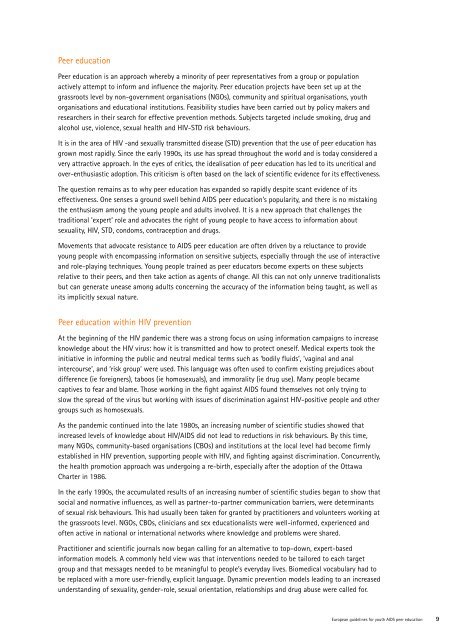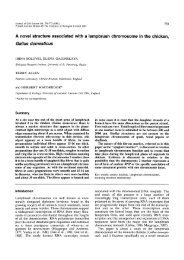European guidelines for youth AIDS peer education - University of ...
European guidelines for youth AIDS peer education - University of ...
European guidelines for youth AIDS peer education - University of ...
- No tags were found...
Create successful ePaper yourself
Turn your PDF publications into a flip-book with our unique Google optimized e-Paper software.
Peer <strong>education</strong>Peer <strong>education</strong> is an approach whereby a minority <strong>of</strong> <strong>peer</strong> representatives from a group or populationactively attempt to in<strong>for</strong>m and influence the majority. Peer <strong>education</strong> projects have been set up at thegrassroots level by non-government organisations (NGOs), community and spiritual organisations, <strong>youth</strong>organisations and <strong>education</strong>al institutions. Feasibility studies have been carried out by policy makers andresearchers in their search <strong>for</strong> effective prevention methods. Subjects targeted include smoking, drug andalcohol use, violence, sexual health and HIV-STD risk behaviours.It is in the area <strong>of</strong> HIV -and sexually transmitted disease (STD) prevention that the use <strong>of</strong> <strong>peer</strong> <strong>education</strong> hasgrown most rapidly. Since the early 1990s, its use has spread throughout the world and is today considered avery attractive approach. In the eyes <strong>of</strong> critics, the idealisation <strong>of</strong> <strong>peer</strong> <strong>education</strong> has led to its uncritical andover-enthusiastic adoption. This criticism is <strong>of</strong>ten based on the lack <strong>of</strong> scientific evidence <strong>for</strong> its effectiveness.The question remains as to why <strong>peer</strong> <strong>education</strong> has expanded so rapidly despite scant evidence <strong>of</strong> itseffectiveness. One senses a ground swell behind <strong>AIDS</strong> <strong>peer</strong> <strong>education</strong>’s popularity, and there is no mistakingthe enthusiasm among the young people and adults involved. It is a new approach that challenges thetraditional ‘expert’ role and advocates the right <strong>of</strong> young people to have access to in<strong>for</strong>mation aboutsexuality, HIV, STD, condoms, contraception and drugs.Movements that advocate resistance to <strong>AIDS</strong> <strong>peer</strong> <strong>education</strong> are <strong>of</strong>ten driven by a reluctance to provideyoung people with encompassing in<strong>for</strong>mation on sensitive subjects, especially through the use <strong>of</strong> interactiveand role-playing techniques. Young people trained as <strong>peer</strong> educators become experts on these subjectsrelative to their <strong>peer</strong>s, and then take action as agents <strong>of</strong> change. All this can not only unnerve traditionalistsbut can generate unease among adults concerning the accuracy <strong>of</strong> the in<strong>for</strong>mation being taught, as well asits implicitly sexual nature.Peer <strong>education</strong> within HIV preventionAt the beginning <strong>of</strong> the HIV pandemic there was a strong focus on using in<strong>for</strong>mation campaigns to increaseknowledge about the HIV virus: how it is transmitted and how to protect oneself. Medical experts took theinitiative in in<strong>for</strong>ming the public and neutral medical terms such as ‘bodily fluids’, ‘vaginal and analintercourse’, and ‘risk group’ were used. This language was <strong>of</strong>ten used to confirm existing prejudices aboutdifference (ie <strong>for</strong>eigners), taboos (ie homosexuals), and immorality (ie drug use). Many people becamecaptives to fear and blame. Those working in the fight against <strong>AIDS</strong> found themselves not only trying toslow the spread <strong>of</strong> the virus but working with issues <strong>of</strong> discrimination against HIV-positive people and othergroups such as homosexuals.As the pandemic continued into the late 1980s, an increasing number <strong>of</strong> scientific studies showed thatincreased levels <strong>of</strong> knowledge about HIV/<strong>AIDS</strong> did not lead to reductions in risk behaviours. By this time,many NGOs, community-based organisations (CBOs) and institutions at the local level had become firmlyestablished in HIV prevention, supporting people with HIV, and fighting against discrimination. Concurrently,the health promotion approach was undergoing a re-birth, especially after the adoption <strong>of</strong> the OttawaCharter in 1986.In the early 1990s, the accumulated results <strong>of</strong> an increasing number <strong>of</strong> scientific studies began to show thatsocial and normative influences, as well as partner-to-partner communication barriers, were determinants<strong>of</strong> sexual risk behaviours. This had usually been taken <strong>for</strong> granted by practitioners and volunteers working atthe grassroots level. NGOs, CBOs, clinicians and sex <strong>education</strong>alists were well-in<strong>for</strong>med, experienced and<strong>of</strong>ten active in national or international networks where knowledge and problems were shared.Practitioner and scientific journals now began calling <strong>for</strong> an alternative to top–down, expert-basedin<strong>for</strong>mation models. A commonly held view was that interventions needed to be tailored to each targetgroup and that messages needed to be meaningful to people’s everyday lives. Biomedical vocabulary had tobe replaced with a more user-friendly, explicit language. Dynamic prevention models leading to an increasedunderstanding <strong>of</strong> sexuality, gender-role, sexual orientation, relationships and drug abuse were called <strong>for</strong>.<strong>European</strong> <strong>guidelines</strong> <strong>for</strong> <strong>youth</strong> <strong>AIDS</strong> <strong>peer</strong> <strong>education</strong> 9
















